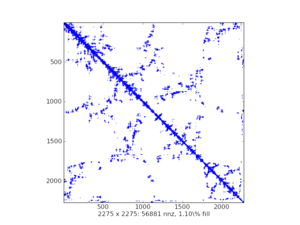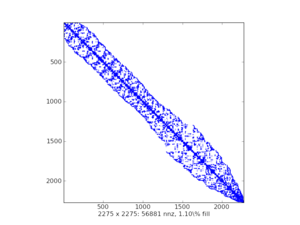2.5.1. 简介¶
(dense) matrix is:
- mathematical object
- data structure for storing a 2D array of values
important features:
- 为所有元素一次分配所有内存
- 通常是一个连续的块,想象一下NumPy ndarray
- 快速访问单个元素(*)
2.5.1.1. Why Sparse Matrices?¶
内存,以n**2增长
small example (double precision matrix):
>>> import numpy as np >>> import matplotlib.pyplot as plt >>> x = np.linspace(0, 1e6, 10) >>> plt.plot(x, 8.0 * (x**2) / 1e6, lw=5) [<matplotlib.lines.Line2D object at ...>] >>> plt.xlabel('size n') <matplotlib.text.Text object at ...> >>> plt.ylabel('memory [MB]') <matplotlib.text.Text object at ...>
2.5.1.2. Sparse Matrices vs. Sparse Matrix Storage Schemes¶
- sparse matrix is a matrix, which is almost empty
- 存储所有的零非常浪费 -> 只存储非零元素
- 考虑压缩
- pros: huge memory savings
- cons: depends on actual storage scheme, (*) usually does not hold
2.5.1.3. 典型应用¶
- solution of partial differential equations (PDEs)
- the finite element method
- 机械工程、电子技术、物理学...
- graph theory
- (i, j)处的非零表示节点i连接到节点j
- ...
2.5.1.4. 先决条件¶
recent versions of
numpyscipymatplotlib(optional)ipython(the enhancements come handy)



